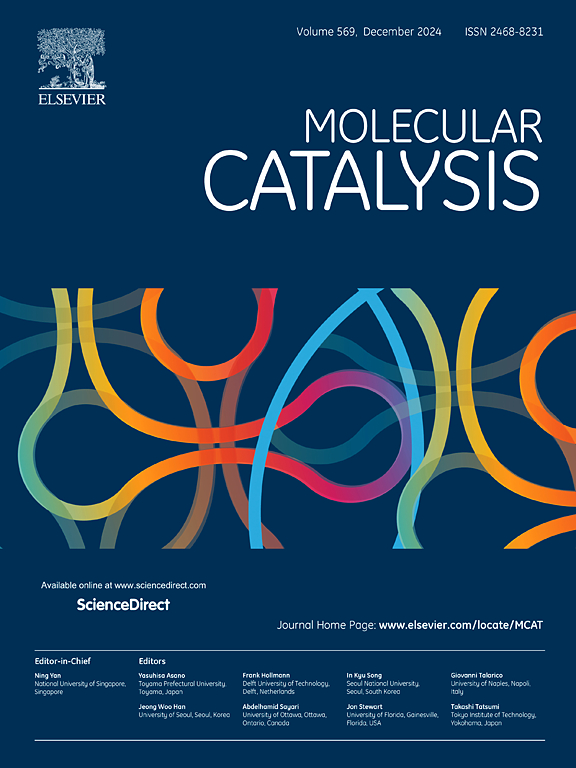Solar-driven PMS activation over Ag/Halloysite nanotubes onto floatable integrated device for pollutant degradation and coupled interfacial water evaporation
IF 4.9
2区 化学
Q2 CHEMISTRY, PHYSICAL
引用次数: 0
Abstract
The solar-driven photothermal photocatalytic contaminant degradation and water evaporation coupled technique is promising for practical wastewater treatment. This study developed photothermal HNTs@Ag/C-5 nanocomposites by polycondensation of tannic acid with silver and following carbonization to construct plasmonic silver nanoparticle onto halloysite nanotubes (HNTs). The incorporation of Ag onto HNTs enhanced electron-hole separation, enabling efficient activation of potassium peroxymonosulfate (PMS) under sunlight. A floatable integrated device was constructed by anchoring the catalyst to a melamine sponge via calcium ion-cross-linked sodium alginate. This device achieved 84.3 % degradation of carbamazepine (CBZ) in 90 min under light, with a reaction rate constant of 0.01685 min−¹, nearly four times higher than unmodified halloysite nanotubes. The photocatalytic PMS activation over HNTs@Ag/C-5 also show great potential for detoxifying other pharmaceutical compounds such as tetracycline (TC) and norfloxacin (NFX) in wastewater. Radical trapping and quenching experiments confirmed hydroxyl radicals (·OH) as the dominant reactive oxidative species in CBZ degradation. Additionally, the device functioned as a solar-driven photothermal evaporator, achieving an evaporation rate of 1.654 kg m−² h−¹. Reusability tests demonstrated consistent performance, with only a 4 % efficiency drop after multiple degradation cycles. This reported monolith evaporator affords possible opportunity for treating complex wastewater when harnessing the evaporation to obtain freshwater and synchronously degrade contaminant.

银/高岭土纳米管上太阳能驱动PMS在可浮式集成装置上的活化,用于污染物降解和耦合界面水蒸发
太阳能驱动的光热光催化污染物降解与水蒸发耦合技术在实际废水处理中具有广阔的应用前景。本研究通过单宁酸与银的缩聚和炭化,在高岭土纳米管(HNTs)上构建等离子体纳米银粒子,制备了光热HNTs@Ag/C-5纳米复合材料。Ag与HNTs的结合增强了电子空穴分离,使过氧单硫酸钾(PMS)在阳光下有效活化。通过钙离子交联海藻酸钠将催化剂锚定在三聚氰胺海绵上,构建了一种可浮式集成装置。该装置在光照下90 min内对卡马西平(CBZ)的降解率达到84.3%,反应速率常数为0.01685 min−¹,比未改性的高岭土纳米管高近4倍。在HNTs@Ag/C-5上的光催化PMS活化也显示出对废水中其他药物化合物如四环素(TC)和诺氟沙星(NFX)解毒的巨大潜力。自由基捕获和猝灭实验证实,羟基自由基(·OH)是CBZ降解的主要氧化物质。此外,该装置还作为太阳能驱动的光热蒸发器,实现了1.654 kg m−²h−¹的蒸发速率。可重用性测试证明了一致的性能,在多次降级循环后,效率仅下降4%。当利用蒸发获得淡水并同步降解污染物时,该报道的单体蒸发器为处理复杂废水提供了可能的机会。
本文章由计算机程序翻译,如有差异,请以英文原文为准。
求助全文
约1分钟内获得全文
求助全文
来源期刊

Molecular Catalysis
Chemical Engineering-Process Chemistry and Technology
CiteScore
6.90
自引率
10.90%
发文量
700
审稿时长
40 days
期刊介绍:
Molecular Catalysis publishes full papers that are original, rigorous, and scholarly contributions examining the molecular and atomic aspects of catalytic activation and reaction mechanisms. The fields covered are:
Heterogeneous catalysis including immobilized molecular catalysts
Homogeneous catalysis including organocatalysis, organometallic catalysis and biocatalysis
Photo- and electrochemistry
Theoretical aspects of catalysis analyzed by computational methods
 求助内容:
求助内容: 应助结果提醒方式:
应助结果提醒方式:


